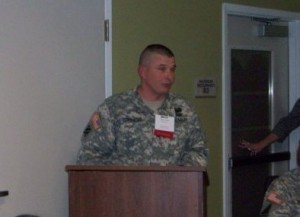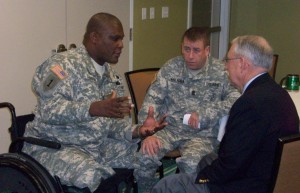By SSG Emily Anderson, WTC Stratcom

AW2 Soldier SFC Leroy A. Petry was awarded the Medal of Honor yesterday, the nation’s highest military award for valor.
Yesterday, AW2 Soldier SFC Leroy A. Petry was awarded the Medal of Honor, the nation’s highest military award for heroism, by President Barack Obama at the White House.
“The service of Leroy Petry speaks to the very essence of America—that spirit that says, no matter how hard the journey, no matter how steep the climb, we don’t quit. We don’t give up,” President Obama said during the award ceremony.
Leroy Petry “showed that true heroes still exist and that they’re closer than you think,” President Obama added.
After months of rehabilitation and therapy, Petry, who joined the Army in September 1999, was able to continue his military career through Continuation on Active Duty (COAD)—an Army program offering many wounded, ill, and injured warriors who desire to continue their Army service, if approved, an opportunity to do so.
Soldiers who meet at least one of three requirements—have served 15-20 years of service, qualify in a critical skill or shortage military occupational specialty, or have a disability as a result of combat or terrorism—can apply to serve through the COAD program, regardless of the extent of their injuries or time in service.
Nearly 177 AW2 Soldiers who are severely wounded, ill, and injured continue to serve in the military. Maintaining these experienced Soldiers is a win-win situation for the Soldier because they are able to continue their military careers, and for the force because the Army benefits from these Soldiers’ skills, experiences, and expertise.
On May 26, 2008, Petry, a Ranger assisting in a daylight helicopter assault mission near Paktya, Afghanistan, and another Ranger, entered an outer courtyard to secure an inner area. Once the inside area was cleared, the two Rangers moved to secure the rest of the vicinity. Unknown to them, the Rangers moved into a section containing enemy fighters.
As the enemies fired upon them, Petry and another Ranger moved to find cover behind a chicken coop, the only available area to shield them.
Before reaching the chicken coop, Petry was wounded by one round, which went through both his legs and the other Ranger, was hit in the side by a separate round. Petry successfully moved the other Ranger out of enemy fire and immediately reported the situation.
When a third Ranger came to their assistance the enemy threw a grenade toward the three Rangers, wounding two of them. Shortly after the first, the enemy threw a second grenade. Realizing the threat, Petry risked his life to save the other Rangers by grabbing the live hand grenade and throwing it away from his fellow Rangers, removing the immediate threat to their lives.
Unfortunately, Petry sustained additional injuries when the grenade detonated shortly after he threw it. The explosion caused the loss of his right hand and multiple shrapnel pieces to penetrate his body.
Despite suffering numerous injuries, Petry remained calm, quickly placed a tourniquet on his right arm and continued to lead.
Once they were out of immediate danger and received medical attention, Petry continued to remain calm and informed the medics about his injuries, which helped them assist Petry with treatment.
“This is the stuff of which heroes are made. This is the strength, the devotion that makes our troops the pride of every American. And this is the reason that—like a Soldier named Leroy Petry— America doesn’t simply endure, we emerge from our trials, stronger, more confident, with our eyes fixed on the future,” said President Obama.
Petry plans to continue what he has been doing for the last 11 years. He will put on the uniform, lace up his boots, and serve his country. He plans to retire from the Army after many more years of service.
Read more about Petry’s story on the U.S. Army website and the Department of Defense website.







